Evergreen's Fitness for the Four Seasons by Dr. Julia Evergreen Keefer: FallEvergreen's Fitness for the Four Seasons by Dr. Julia Evergreen Keefer
julia.keefer@nyu.edu
Part Three: Healthy, Happy Harvest 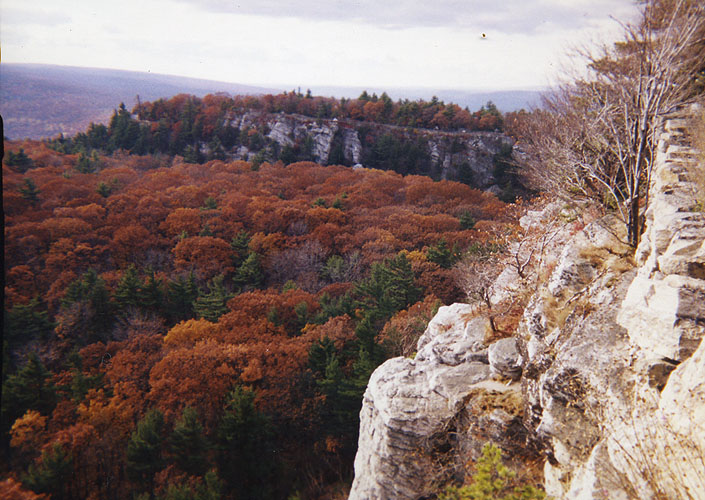
Ch13: Aerobic Activity: Biking
The ways that biking outdoors apply to cycling indoors. 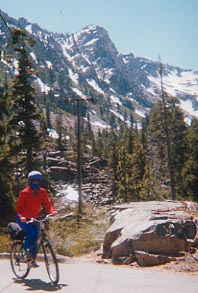 Evergreen tackles the Sierras! I also biked the famous Slickrock Trail in Utah. Afterwards, it's important to stretch.
Evergreen tackles the Sierras! I also biked the famous Slickrock Trail in Utah. Afterwards, it's important to stretch. 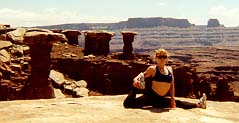 When biking indoors, go on imaginary trips to these places.
When biking indoors, go on imaginary trips to these places.
Technique and Tricks on Your Stationary Bike
A recumbent bike is the safest, easiest way to combine housework and aerobics for Level I. Sit down and bike for ten minutes, while stretching your upper body. Then do an hour of housework and get back on. Make sure you are sitting on your sit bones, not your tail bone.
An indoor bike is a lighter bike that takes up less room and allows you to get out of the seat in positions two and three so you can better target your abdominals, back and buttocks. Johnny G (Goldstein) first patented the indoor bike, and currently offers home models, manuals, and classes. www.spinning.com
Set-up
Buy a heart rate monitor for forty dollars.
Your heel over the pedal in six o’clock should be ninety degrees.
The knee should bend at ninety degrees over the center of the shoe when the feet are at 3 and 9.
Posture
Beginning bikers often lean on the handlebars, clench their fists, tighten their shoulders and round their backs too much when leaving the saddle.
First Position: Sit and Sweat 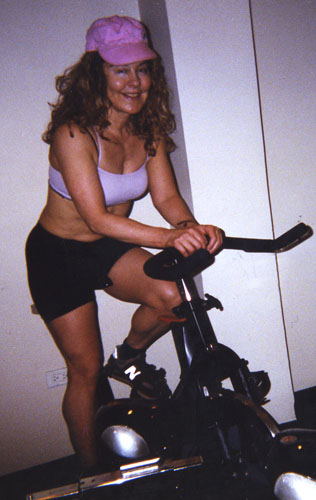 Do some warm-up stretches, particularly if you are combining the indoor cycling with housework. First position simply means that you sit on the saddle and put your hands together on the handlebars. Sit back on the saddle so it doesn’t hurt your crotch. Do an upper body warm-up as you pedal gently. Look right and left, up and down and side to side. Shrug your shoulders. Stretch your arms overhead.
Do some warm-up stretches, particularly if you are combining the indoor cycling with housework. First position simply means that you sit on the saddle and put your hands together on the handlebars. Sit back on the saddle so it doesn’t hurt your crotch. Do an upper body warm-up as you pedal gently. Look right and left, up and down and side to side. Shrug your shoulders. Stretch your arms overhead. 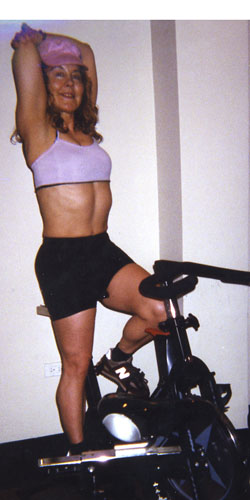 Stretch the shoulder and chest stretches.
Stretch the shoulder and chest stretches. 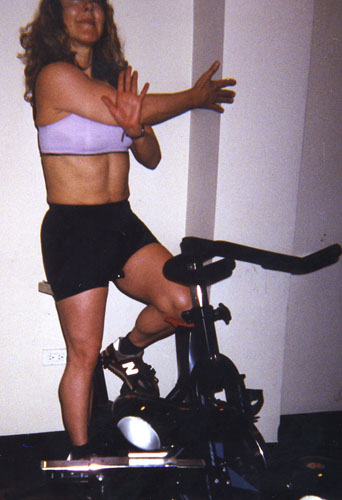 First position is a great position to do sprints because you can focus only on speed, not on maintaining your alignment out of the seat. You can use your core muscles while you bike. Do crunch-downs. Exhale and contract your abdominal muscles allowing your elbows to bend slight. Let the abdominals initiate the movement--don’t turn it into a push-up. Don’t hold your breath or collapse your rib cage. This should improve your diaphragmatic breathing, not hinder it.
First position is a great position to do sprints because you can focus only on speed, not on maintaining your alignment out of the seat. You can use your core muscles while you bike. Do crunch-downs. Exhale and contract your abdominal muscles allowing your elbows to bend slight. Let the abdominals initiate the movement--don’t turn it into a push-up. Don’t hold your breath or collapse your rib cage. This should improve your diaphragmatic breathing, not hinder it.
Do a cadence check. Either count every time the top of your thigh hits your hand or goes down towards the floor in one minute. The highest RPM or cadence is 110, depending on the bike.
The first imagery should be developing smooth strokes, all points of the dial, scraping off the bottom of your shoe, lifting up to your chest, and throwing forward as if it were a ball.
Beginners shouldn't do anything but sit in the saddle with light to moderate resistance or a brief standing flat.
Second Position: High and Dry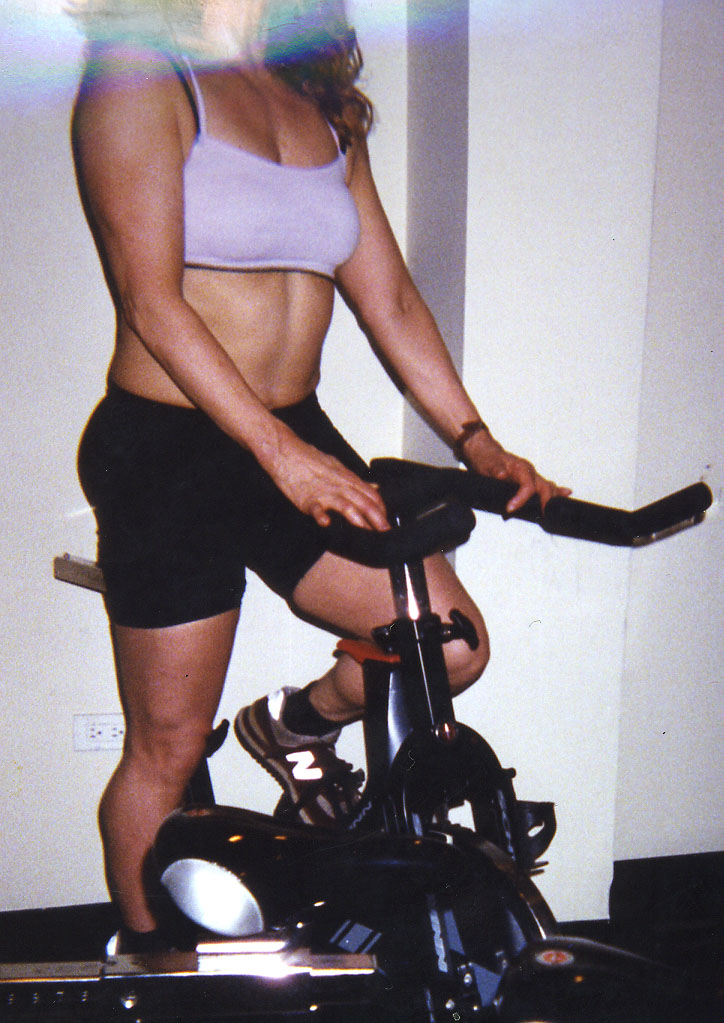
Second position hands are wide on the handlebars. Stand up as if you were jogging. Play bounce and balance. At first just let your body go. Then pretend you have an open bottle of champagne balanced on your head. Use your core muscles to keep the torso completely still. You will feel a burn in your thighs and you may have to slow down.
Levels II and III can do a standing run with resistance.
Interval is a wide range from 40 to 92.
Level II shouldn't exceed 85%.
Third Position: Tail Off the Seat Like a Cat in Heat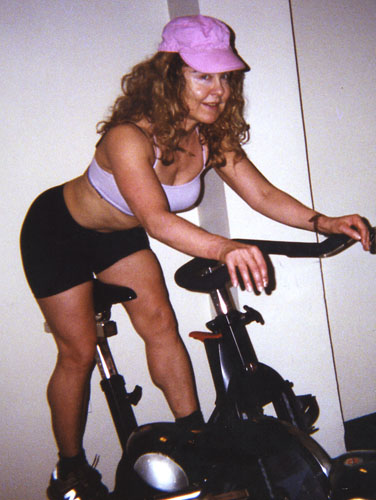
In this position most people fail to lengthen their spines and keep their hips over the seat. Don’t come forward or put weight and tension into your hands. Think of arching your back. When climbing put enough resistance on that you can't exceed 80 RPM or go lower than 60 RPM. This means no standing flats or sprints.
Jumps, Sprints and Breakaways
Jumps are rhythmic movements from one position to the next that force you to use your core muscles. When you jump from one to two imagine you are a Jack-in-the box. You can do slow jumps counting to 8 or faster ones in 2 counts. Your buttocks initiate the movement. When you jump back and forth from two to three hinge at the hips and use your abdominals. Switchbacks, hills, rocks, ledges are all part of a spinning spic and span class.
If you have had recent knee injuries, stay seated in the saddle and avoid positions two and three as well as heavy resistance.
In a race there are no jumps or recovery in the middle. You can also end with a sprint. It should be 85 to 92%.
Cool-down by biking easily in first with no resistance and then stretch again, particularly the hands if you are going back to housework. 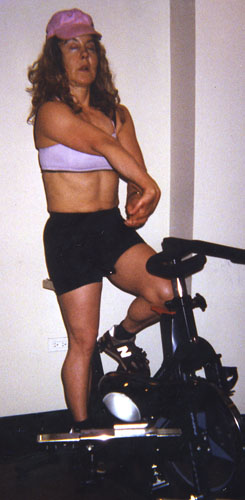 Notice how I close my eyes to visualize complete relaxation. This is a good way to bring down the diastolic blood pressure after an aerobic workout.
Notice how I close my eyes to visualize complete relaxation. This is a good way to bring down the diastolic blood pressure after an aerobic workout.
Ch14: Skill: Agility
Jump rope, do cariocas, plyo and other agility drills on the grass or trampoline.
Jump rope any time any place for a few minutes to get your heart rate up.
Performance training necessitates rapid directional changes and explosive power executed with efficient, economical movement dynamics.
Plyometric, sometimes called jump training although it can include throwing and catching balls, is the use of eccentric contraction followed by an amortization or transitional phase into a burst of concentric contraction. In other words, you bend your knees, stretching your calf muscles, quads and hips and then jump up, engaging your feet knees and hips in extension. Power is force times distance divided by time. In other words, how high, far and fast can you jump with as heavy a resistance as possible? The more something is stretched the greater the release, provided the stretch doesn’t last as long as a yoga stretch.
Some trainers recommend that you don’t jump until you can squat 1 and a half times your body weight. I say until feet are strong and alignment is good. Don’t throw until you can press your weight. That doesn't work for many women so just be careful of pre-existing injuries and listen to your body.
Balance and Agility Progression Program
Double weight support for balance static
Eyes closed
Tandem stance eyes open and closed
Single leg support stork eyes open and closed
Stork stand on trampoline eyes open and closed
Stork stand with complex activity while playing catch
on ground and on trampoline
Two leg support on Bosu board
One leg support trampoline jumping
One leg support hopping on ground
Retrowalking
Step-up
Running
Jumping
Stars, squat thrusts, jumping jacks
Jump rope
Standing jumps and hip twists like mogul skiing
Standing jump and reach like basketbal
Lateral, forward-backward, command jumping
Lateral hopping
Forward-backward hopping
Command hopping
Cariocas
Plyo box jumping
Sport activities
Line, target and zigzag jumping.
Natural weights are wood, buckets, jugs, cat litter, sandbags.
Once you are back to normal, shuffle the order and jolt yourself with interval training, --intermittent, interval training where surprise is the name of the game, drills are constantly shuffled around, and sequences are never repeated. The idea is to push the performers off their plateau.
Kids’ toys can be markers for drills. Pushing car out of a ditch is great exercise. Do pull-ups and chinups on monkey bars or climb all monkey bars.
Don’t keep doing jumping jacks on carpet covered concrete. But running outside on the dirt, jumping rope on a soft surface, doing cardio drills-that is okay. Notice how I jump on a natural sprung floor on the ground.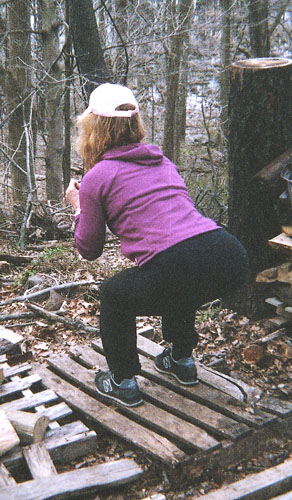
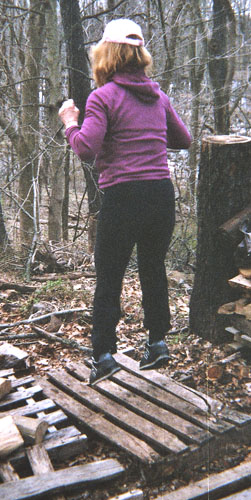 Don't do this exercise if the wood is rotten.
Don't do this exercise if the wood is rotten.
Do walking lunges across the lawn, holding a tree stump. Bring the arms straight overhead as you step out on your front leg. Then do rotational lunges, touching the stump to the outside of the knee as you bend into a lunge.
Do bunny hops, lateral hops.
As you walk, kick one leg up to meet the opposite hand. You can also do this skipping. Keep your legs straight for more exertion. But if you have a bad back or tight hamstrings, bend the knee.
As you walk, rotate the knee outwards. You can also try this with kicks.
In progressions, first we have balance, then coordination, then agility. Some people never proceed to agility so do it in the pool. Jumping, cutting, pivoting and twisting should only be done if you are in good shape and have no injuries.
Ch15: Chores: The Wheelbarrow and Housework
Jump rope while you gather fruits and nuts, rake leaves
Paint, Polish, Puff those Pillows with Pump Power
Pedal to your fantasy vacation as you clean house.
Polish, Paint, and Punch with Pump PowerWhen I first started teaching for the Arthritis Foundation I was amazed that they recommended ways to avoid housework by eliminating unnecessary chores, unused equipment, a second trip to town, an extra flight of stairs, and to use space efficiently with step shelves, dividers and a lazy susan. "Sit and eliminate stairs whenever possible, reduce all unnecessary walking, push or slide heavy objects, don’t lift."
Am I suggesting the opposite--that you do more chores, climb more stairs, and walk as much as possible? Yes, but only if you do so in good alignment, listening to your body. When your body is exhausted, find ways to avoid chores. Chores become chores when you are too tired and bored to do them. Don’t do the same thing in the same way seven days a week.
You should use tools with big grip areas however.
Back and Forth
Sweeping, Vacuuming and Mopping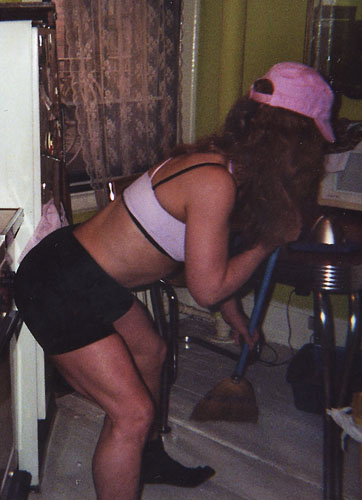
Stand upright to clean floors, vacuum and sweep with long handles to avoid bending. If you must bend, keep your back straight, bend your knees, and do the rotation from the upper body only.
Scrubbing, Polishing and Dusting
Switch to your weaker hand to avoid overuse
Making Beds
Making beds is a horizontal action, which could hurt your back, if you reach across in a twisted fashion without warming up. Climb on all fours over the bed and add a few back exercises in between straightening sheets. Try kneeling rather than bending forward to tuck in a corner on the bed. Walk around it rather than reach across. If possible, put the bed on castors so you can roll it away from the wall to change the sheets. After you have smoothed out the bedspread, lie on your back, and do the psoas stretch off the end.
Up and Down
Washing and Painting Windows and Walls
These up and down movements really work your lats. 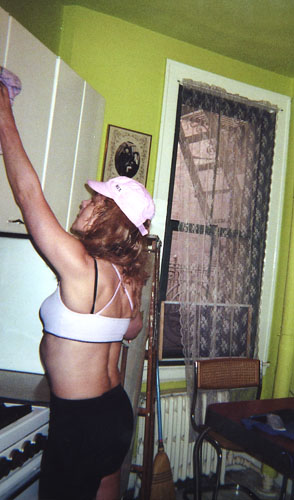 On the other hand, they can stress the rotator cuff, in which case you turn back to the Sore Shoulders section of Dr. Keefer’s Corrective Clinic.
On the other hand, they can stress the rotator cuff, in which case you turn back to the Sore Shoulders section of Dr. Keefer’s Corrective Clinic. Try to avoid this twisted position for long periods of time.
Try to avoid this twisted position for long periods of time.
Stretch your rotator cuff muscles periodically. Work both sides of the back equally.
Loads and Laundry
Every time you shop you are carrying weights. Try to get bags with handles and balance the loads equally. Climbing the stairs with the bags is a great workout. Before you put them away, do some deltoid raises, lifting and lowering the bags for 12 reps.
For me, laundry involves carrying heavy weights up and down three flights of stairs. Examine your load: if it is too heavy, cut it in half. Remember that this is endurance not maximum strength training. If you max out, you won’t be able to carry your laundry home.
Pain
Too much housework can hurt the back or the hands. Stop, stretch, realign and if necessary postpone tasks to another day.
I hate housework. My studio was filthy and disorganized until I devised a way to combine housecleaning with exercise. If you like housework but hate exercise, Paint, Polish, Punch with Pump Power may work the other way for you so that you use your cardio intervals to plan your next chore, talk to family members or just relax your mind as you pump your thighs.
Posture: Every so often stand with your back against the wall. Make sure the back of your head, your ribs, your buttocks and your heels touch the wall, but let your lower back arch slightly.
Performance: Even if it is dirty, don’t scrub so hard your hands hurt. Move efficiently and save your aerobic energy for biking.
Purr or Puke? When I do housework, I sometimes get so depressed I feel like puking. Put on your favorite music, take a spin as you purr, imagining a trip through beautiful mountains, work up to a prance and pounce energy, and then continue to clean with a purr focus.
Outdoor ChoresWhen using tools of any kind, take breaks to stretch your wrists and wiggle your fingers.
The Fruits and Nuts of the Wheelbarrow
For several years, I paid for a night in the country by working the wheelbarrow.

 Don't keep rounding the back to drop the wood into the wheelbarrow. Just drop it. Picking it up is another matter.
Don't keep rounding the back to drop the wood into the wheelbarrow. Just drop it. Picking it up is another matter. 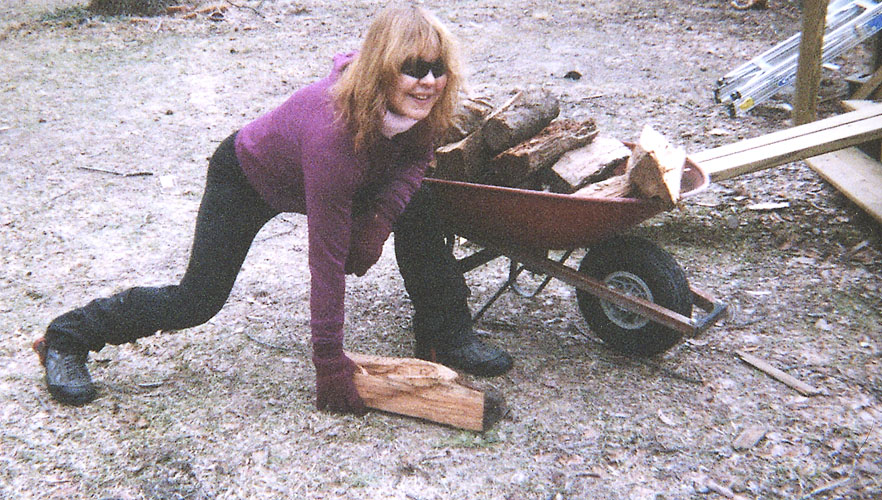 But when picking up acorns, you might want to take a long back stretch.
But when picking up acorns, you might want to take a long back stretch.
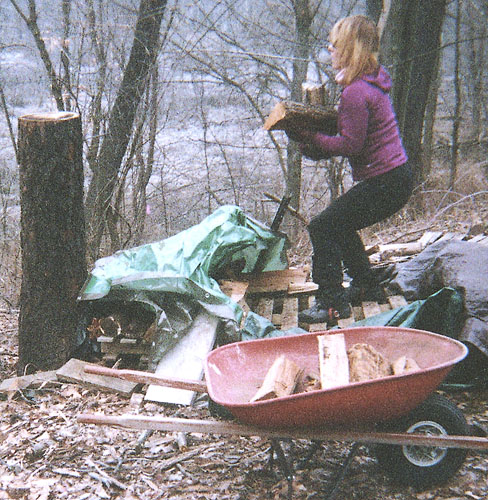 Hold the wood and do squats for more tonus in the butt.The hardest part was pushing a heavy wheelbarrow filled with wood onto the porch. Notice how I straddle the ramp, bend my knees, keep my back straight, and squeeze my lats to avoid rounding my shoulders. I keep this posture as I push the wheelbarrow up the ramp.
Hold the wood and do squats for more tonus in the butt.The hardest part was pushing a heavy wheelbarrow filled with wood onto the porch. Notice how I straddle the ramp, bend my knees, keep my back straight, and squeeze my lats to avoid rounding my shoulders. I keep this posture as I push the wheelbarrow up the ramp.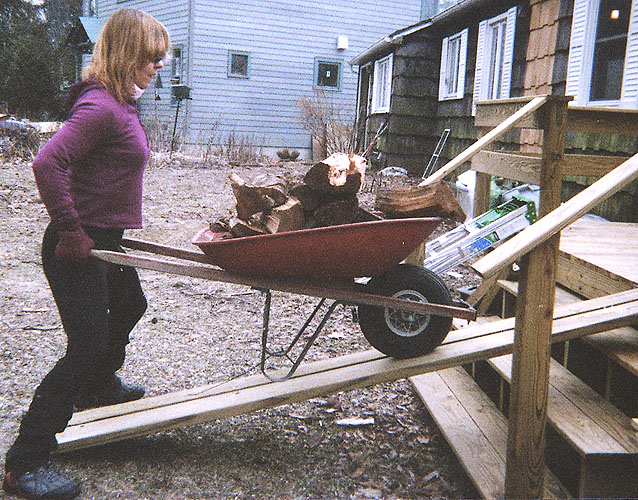
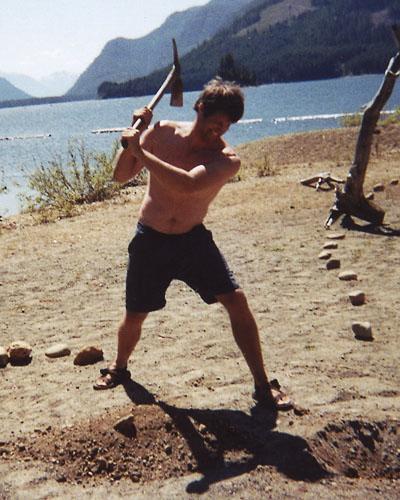 Chopping is a great workout for the whole body, particularly the abs. Balance in a strong lunge, bend your knees, and exhale as you hit it.
Chopping is a great workout for the whole body, particularly the abs. Balance in a strong lunge, bend your knees, and exhale as you hit it.
Raking LeavesRaking and hoeing work the lats and pecs but don't round forward.
When using tools of any kind, take breaks to stretch your wrists and wiggle your fingers.
Ch16: EvergreenEnergy ™
Static strengthening with the patent-pending EvergreenEnergy band. ™
Here are some exercises you can do with the EvergreenEnergy band™ while enjoying the beauty of the wilderness.
 Lateral Deltoid
Lateral Deltoid
1) Stand with the band under your feet, holding the two sides with your arms by your side.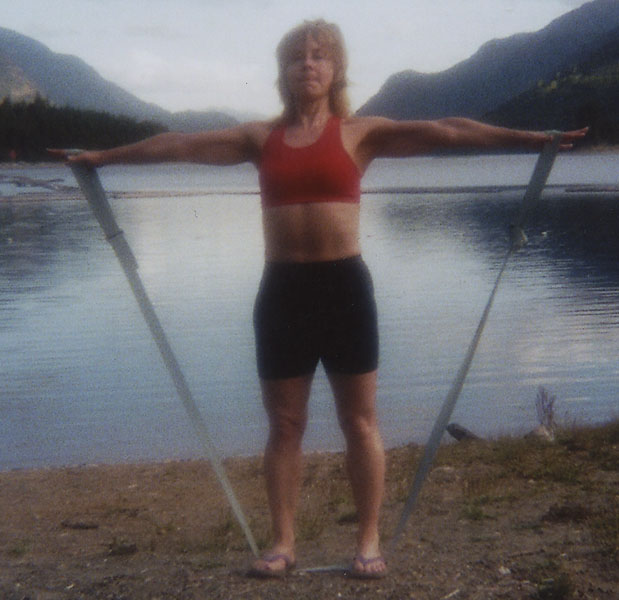 Exhale and lift your arms to shoulder level, parallel to the ground. Return SLOWLY to the starting position.
Exhale and lift your arms to shoulder level, parallel to the ground. Return SLOWLY to the starting position.
Front Deltoid
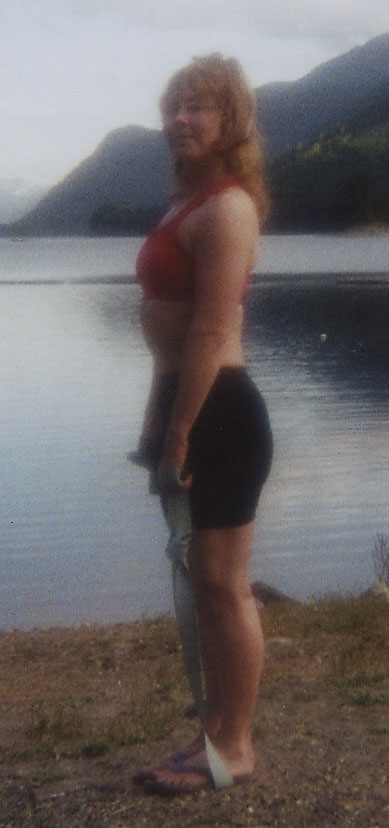 As you lift your arms in front of you, keep your back muscles engaged and your shoulders down.
As you lift your arms in front of you, keep your back muscles engaged and your shoulders down. 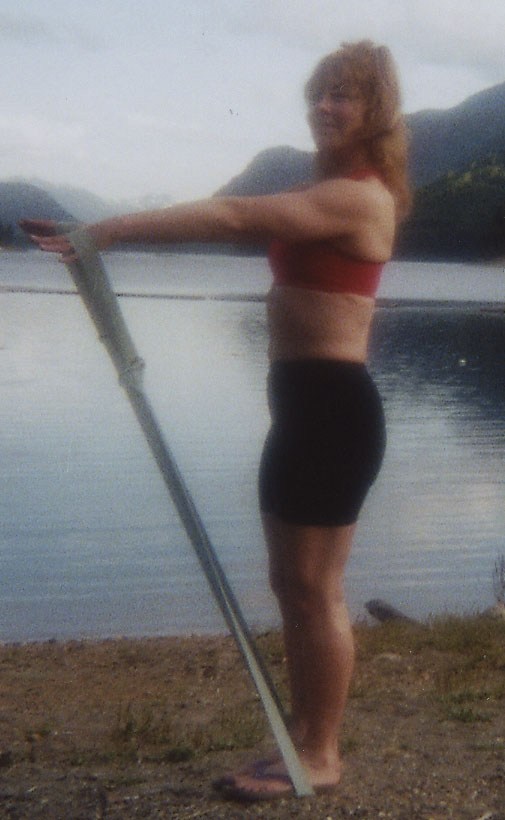
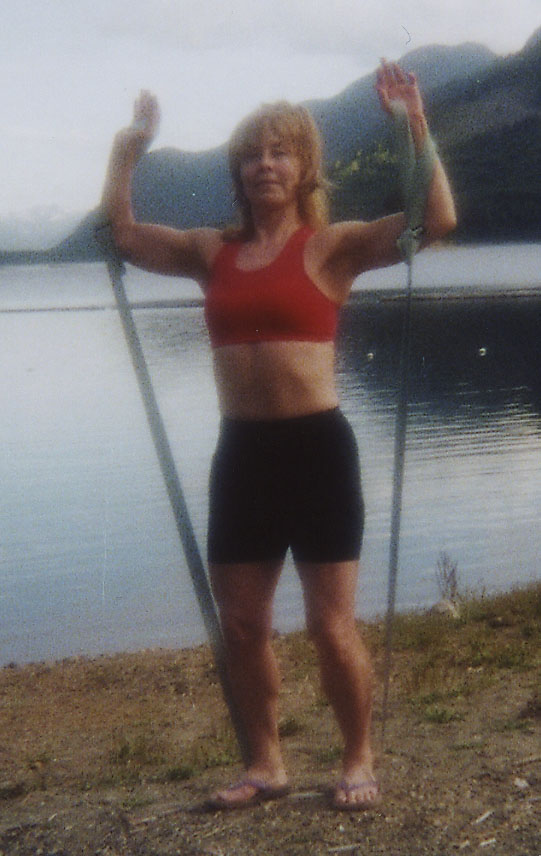 Overhead Press
Overhead Press
Rotate your shoulder blades down your back as you extend your arms to the sky.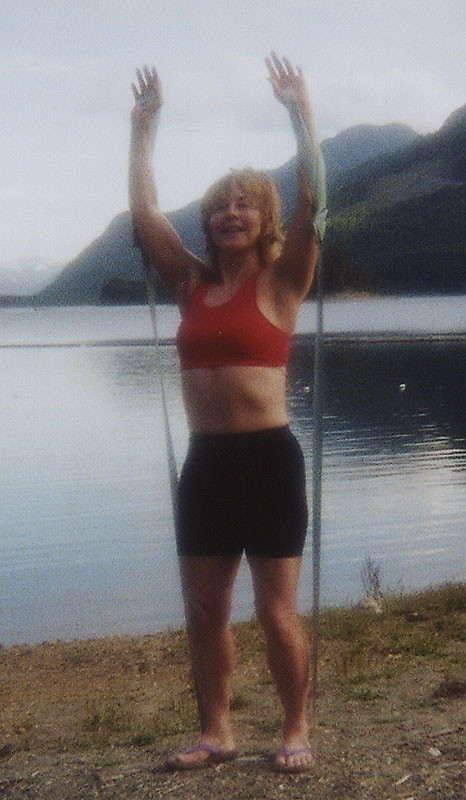
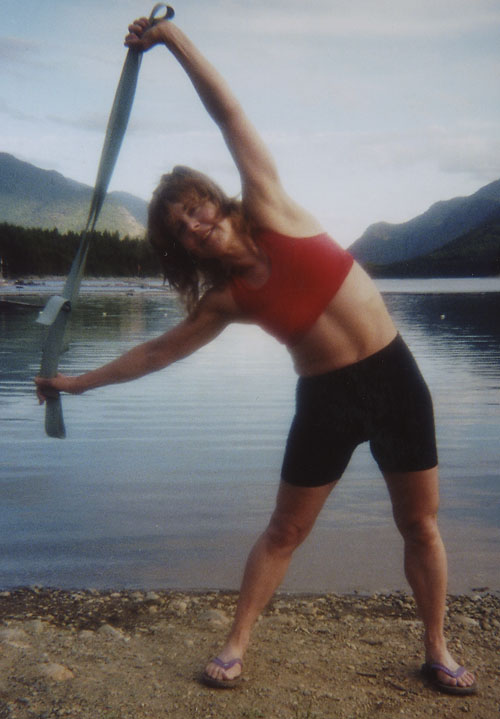 Lateral bending with the band is only for Levels II and III. If you have a bad back, keep one hand on your thigh and don't use the band.
Lateral bending with the band is only for Levels II and III. If you have a bad back, keep one hand on your thigh and don't use the band.
 Attach the band around a firm pillar over your head and stand as far away as your strength permits. Exhale and contract your abdominals as you bend over. Try it with your knees bent slightly, and with the legs straight.
Attach the band around a firm pillar over your head and stand as far away as your strength permits. Exhale and contract your abdominals as you bend over. Try it with your knees bent slightly, and with the legs straight.
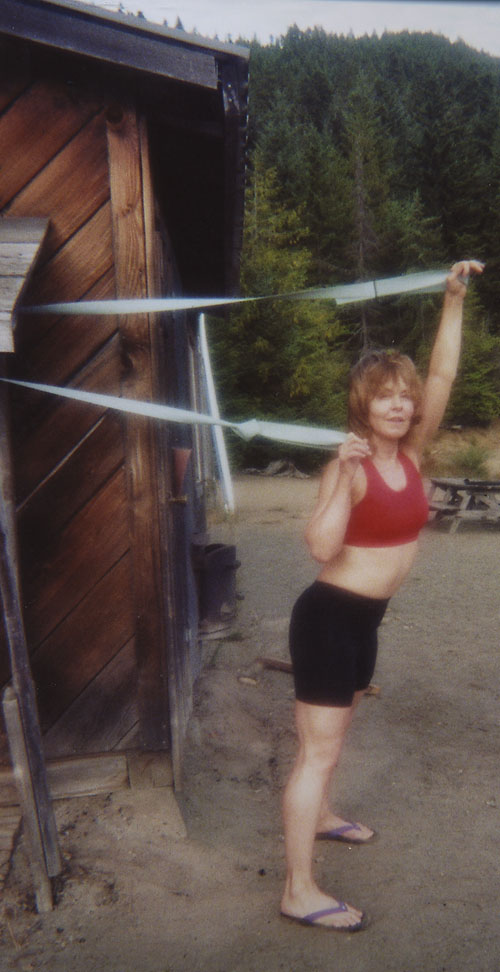 To work the obliques, begin with one hand higher than the other. As you exhale, contract your oblique abdominals as you bend towards the opposite knee, foot, or ground, depending on your flexibility.
To work the obliques, begin with one hand higher than the other. As you exhale, contract your oblique abdominals as you bend towards the opposite knee, foot, or ground, depending on your flexibility. 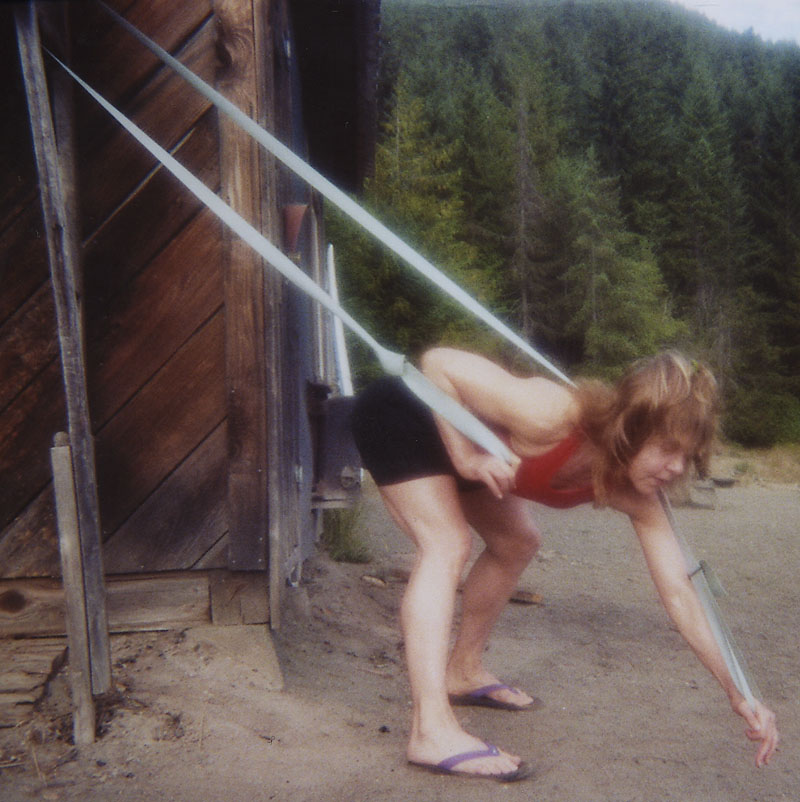
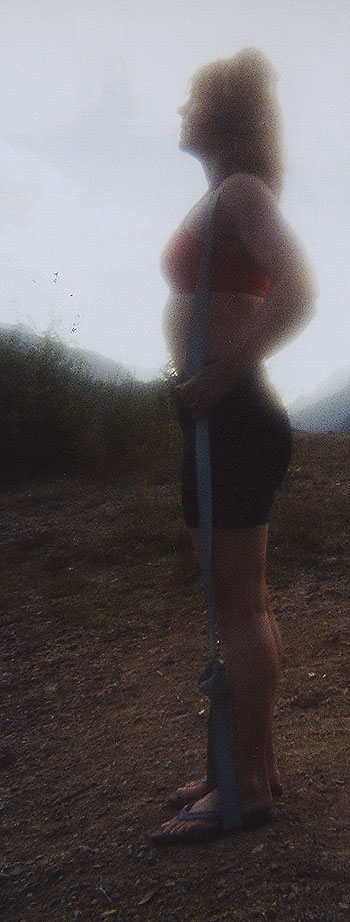 You can do both open and closed chain leg exercises with the band. For open chain, begin with the band under the feet. Lift the leg to ninety degrees or higher. Hold the thigh parallel to the ground, and do a slight bend and straighten the knee.
You can do both open and closed chain leg exercises with the band. For open chain, begin with the band under the feet. Lift the leg to ninety degrees or higher. Hold the thigh parallel to the ground, and do a slight bend and straighten the knee. 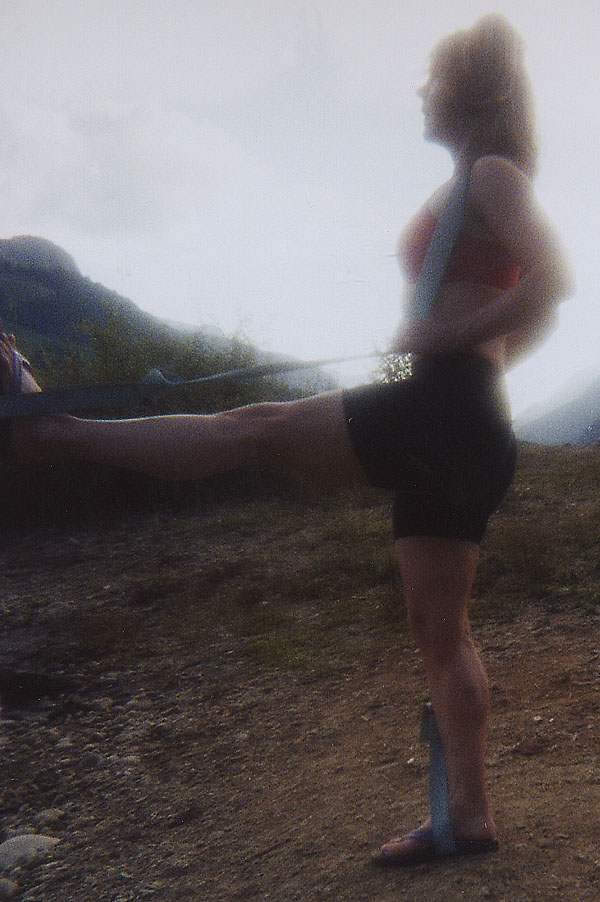 Return to starting position slowly.
Return to starting position slowly.
Closed chain squats
Attach the band around the shoulders, pulling it tautly from the feet and slowly squat back. 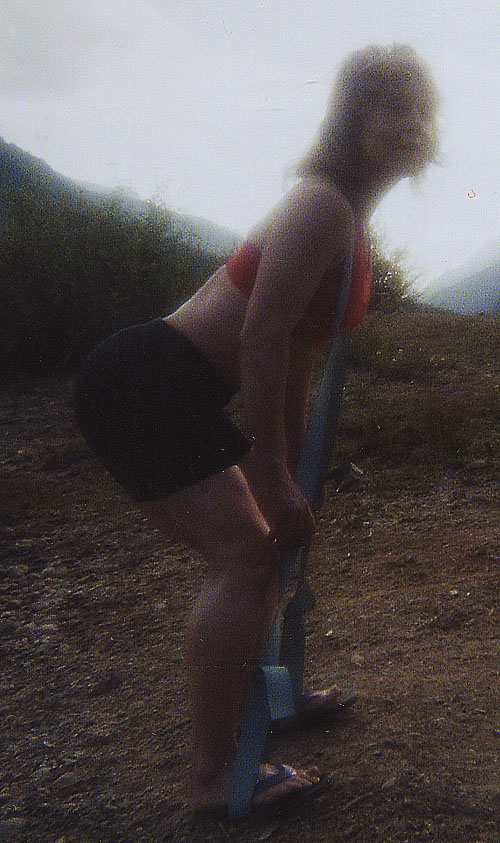 Ballerina squats
Ballerina squats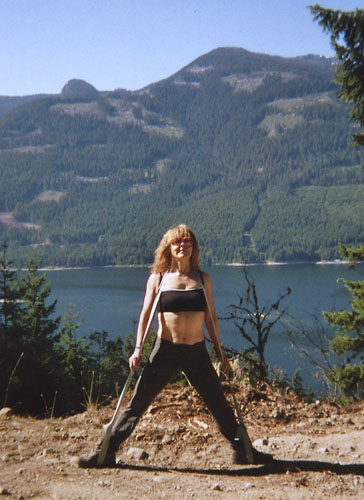 are done the same way except that you turn your hips out. Make sure you don't over-turnout--keep the kneecaps pointing towards the third toes with the insteps lifted.
are done the same way except that you turn your hips out. Make sure you don't over-turnout--keep the kneecaps pointing towards the third toes with the insteps lifted. 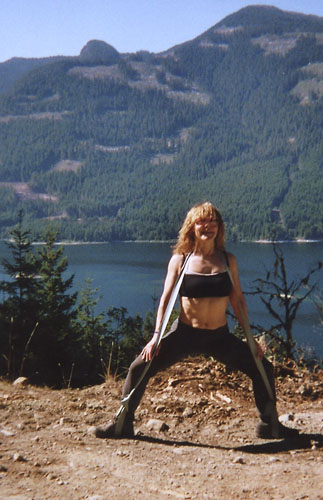 Unlike parallel squats, the hips must stay directly under your shoulders as you bend your knees.
Unlike parallel squats, the hips must stay directly under your shoulders as you bend your knees.
Work open chain buttock exercises 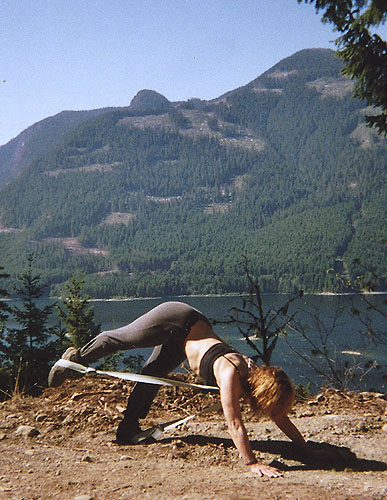 with this extreme stretch for Level III.
with this extreme stretch for Level III. 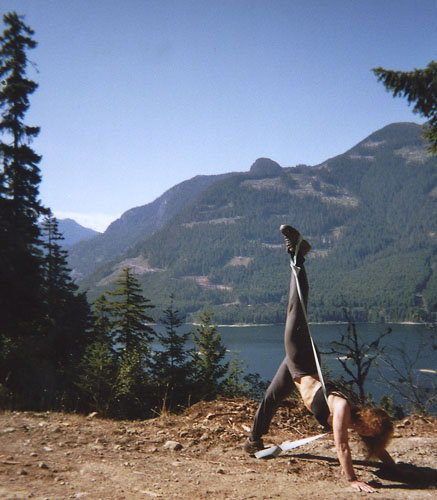
 This is the starting position for bicep curls--palms up, palms down, or hammer curls--to target different muscles.
This is the starting position for bicep curls--palms up, palms down, or hammer curls--to target different muscles. 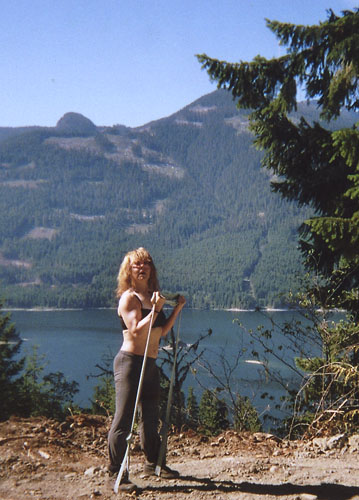
Lat Pulldown 
Work the lats by bending your arms and pulling your elbows to your ribs, while maintaining a flat back.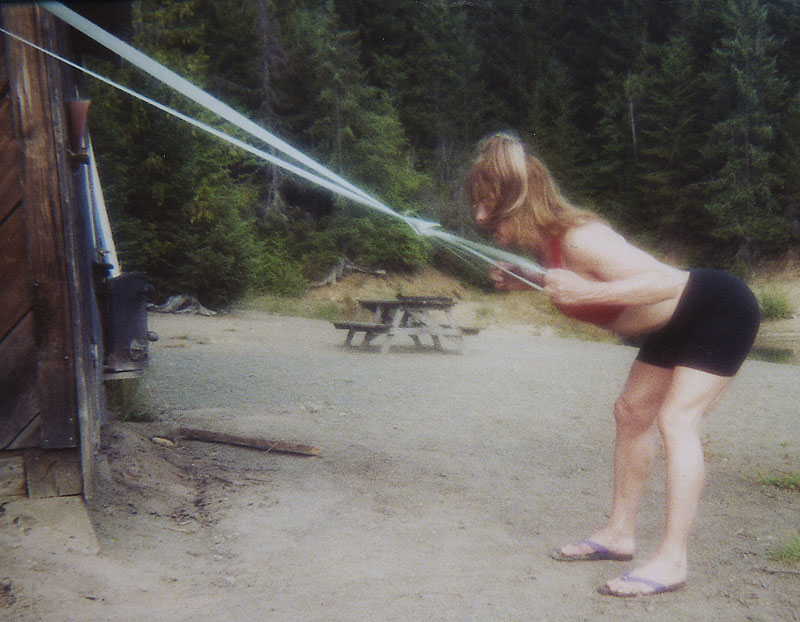 Adductors
Adductors
Tone your inner thighs by lying on your back with your legs open, with the band behind your waist and attached around each instep. As you bring your legs together, squeeze the inner thighs and pull in the opposite direction with the hands. For more fun, add a sit-up.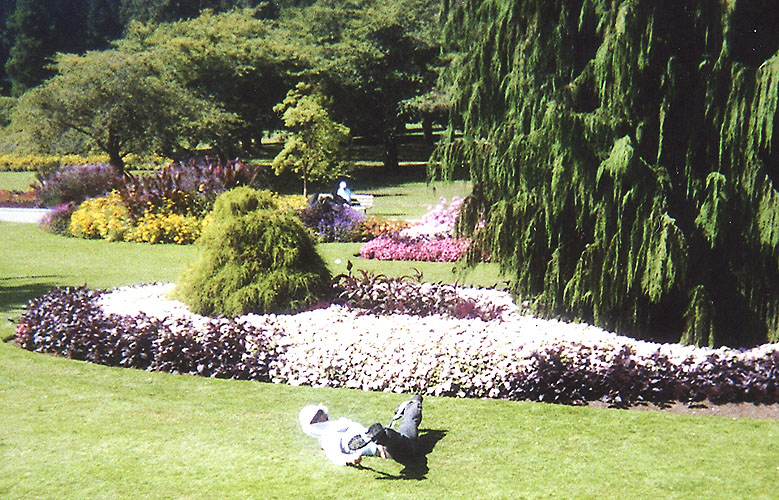
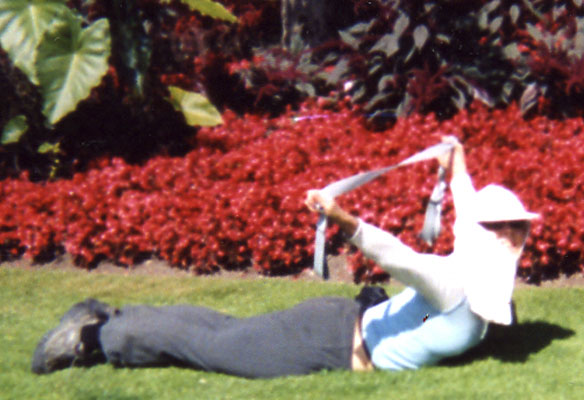 This stretch will improve your flexibility for yoga and dance but don't use the band if you have sore shoulders or a bad back.
This stretch will improve your flexibility for yoga and dance but don't use the band if you have sore shoulders or a bad back.
Next time you are sitting on a park bench, wrap the band around the back of the seat to do seated flys.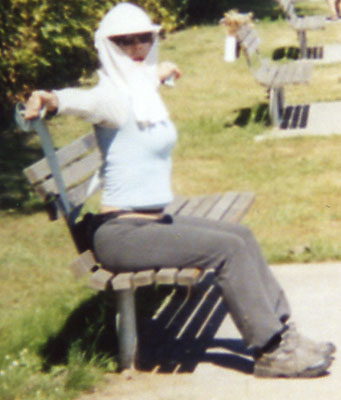
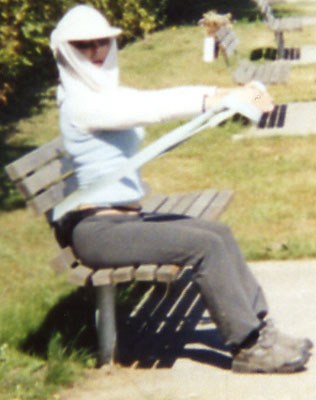 Then bring your arms overhead for deltoid presses and tricep extensions.
Then bring your arms overhead for deltoid presses and tricep extensions.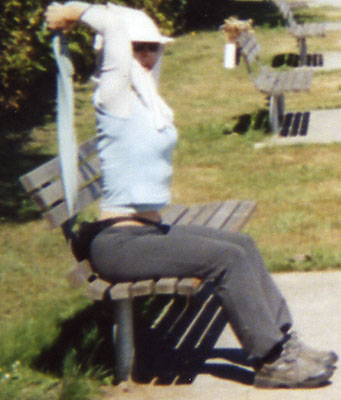
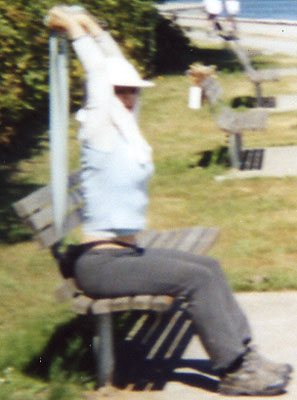 To do crunchdowns begin in the overhead position, contract your abs pulling the band with you behind your head.
To do crunchdowns begin in the overhead position, contract your abs pulling the band with you behind your head. Work the back muscles and lats.
Work the back muscles and lats.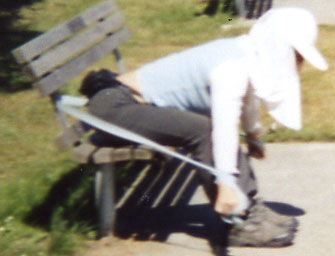
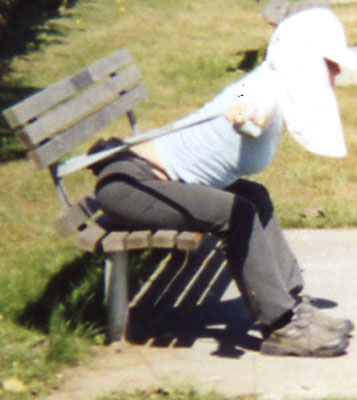 Add rotations and do one arm at a time for better results.
Add rotations and do one arm at a time for better results.
Take the EvergreenEnergy band on your next trip. I took it to a destination wedding near the North Pole and when I returned I was able to lift some usual round of heavy weights at the gym without any loss of strength or flexibility!
Ch17: Mental/Spiritual
Focus on the heart, brain, and aura as you develop your imagination to envision a project greater than yourself.
Ch18: Environmental
Now that you are in shape, work for an environmental project.
Will it be a Wicked or a Wonderful Winter?
KNOCKOUT STEP/SLIDE/STRIKE
KNOCKOUT BALLET 'N BOX
KNOCKOUT CARDIO-CORE with AEROBIC GUT AND BUTT
EVERGREENENERGY
Dr. Keefer's Corrective Clinic

 Evergreen tackles the Sierras! I also biked the famous Slickrock Trail in Utah. Afterwards, it's important to stretch.
Evergreen tackles the Sierras! I also biked the famous Slickrock Trail in Utah. Afterwards, it's important to stretch.  When biking indoors, go on imaginary trips to these places.
When biking indoors, go on imaginary trips to these places.  Do some warm-up stretches, particularly if you are combining the indoor cycling with housework. First position simply means that you sit on the saddle and put your hands together on the handlebars. Sit back on the saddle so it doesn’t hurt your crotch. Do an upper body warm-up as you pedal gently. Look right and left, up and down and side to side. Shrug your shoulders. Stretch your arms overhead.
Do some warm-up stretches, particularly if you are combining the indoor cycling with housework. First position simply means that you sit on the saddle and put your hands together on the handlebars. Sit back on the saddle so it doesn’t hurt your crotch. Do an upper body warm-up as you pedal gently. Look right and left, up and down and side to side. Shrug your shoulders. Stretch your arms overhead.  Stretch the shoulder and chest stretches.
Stretch the shoulder and chest stretches.  First position is a great position to do sprints because you can focus only on speed, not on maintaining your alignment out of the seat. You can use your core muscles while you bike. Do crunch-downs. Exhale and contract your abdominal muscles allowing your elbows to bend slight. Let the abdominals initiate the movement--don’t turn it into a push-up. Don’t hold your breath or collapse your rib cage. This should improve your diaphragmatic breathing, not hinder it.
First position is a great position to do sprints because you can focus only on speed, not on maintaining your alignment out of the seat. You can use your core muscles while you bike. Do crunch-downs. Exhale and contract your abdominal muscles allowing your elbows to bend slight. Let the abdominals initiate the movement--don’t turn it into a push-up. Don’t hold your breath or collapse your rib cage. This should improve your diaphragmatic breathing, not hinder it.

 Notice how I close my eyes to visualize complete relaxation. This is a good way to bring down the diastolic blood pressure after an aerobic workout.
Notice how I close my eyes to visualize complete relaxation. This is a good way to bring down the diastolic blood pressure after an aerobic workout. 
 Don't do this exercise if the wood is rotten.
Don't do this exercise if the wood is rotten. 
 On the other hand, they can stress the rotator cuff, in which case you turn back to the Sore Shoulders section of Dr. Keefer’s
On the other hand, they can stress the rotator cuff, in which case you turn back to the Sore Shoulders section of Dr. Keefer’s  Try to avoid this twisted position for long periods of time.
Try to avoid this twisted position for long periods of time. 
 Don't keep rounding the back to drop the wood into the wheelbarrow. Just drop it. Picking it up is another matter.
Don't keep rounding the back to drop the wood into the wheelbarrow. Just drop it. Picking it up is another matter.  But when picking up acorns, you might want to take a long back stretch.
But when picking up acorns, you might want to take a long back stretch.
 Hold the wood and do squats for more tonus in the butt.The hardest part was pushing a heavy wheelbarrow filled with wood onto the porch. Notice how I straddle the ramp, bend my knees, keep my back straight, and squeeze my lats to avoid rounding my shoulders. I keep this posture as I push the wheelbarrow up the ramp.
Hold the wood and do squats for more tonus in the butt.The hardest part was pushing a heavy wheelbarrow filled with wood onto the porch. Notice how I straddle the ramp, bend my knees, keep my back straight, and squeeze my lats to avoid rounding my shoulders. I keep this posture as I push the wheelbarrow up the ramp.
 Chopping is a great workout for the whole body, particularly the abs. Balance in a strong lunge, bend your knees, and exhale as you hit it.
Chopping is a great workout for the whole body, particularly the abs. Balance in a strong lunge, bend your knees, and exhale as you hit it.
 Lateral Deltoid
Lateral Deltoid Exhale and lift your arms to shoulder level, parallel to the ground. Return SLOWLY to the starting position.
Exhale and lift your arms to shoulder level, parallel to the ground. Return SLOWLY to the starting position.  As you lift your arms in front of you, keep your back muscles engaged and your shoulders down.
As you lift your arms in front of you, keep your back muscles engaged and your shoulders down. 
 Overhead Press
Overhead Press
 Lateral bending with the band is only for Levels II and III. If you have a bad back, keep one hand on your thigh and don't use the band.
Lateral bending with the band is only for Levels II and III. If you have a bad back, keep one hand on your thigh and don't use the band. Attach the band around a firm pillar over your head and stand as far away as your strength permits.
Attach the band around a firm pillar over your head and stand as far away as your strength permits. 
 To work the obliques, begin with one hand higher than the other. As you exhale, contract your oblique abdominals as you bend towards the opposite knee, foot, or ground, depending on your flexibility.
To work the obliques, begin with one hand higher than the other. As you exhale, contract your oblique abdominals as you bend towards the opposite knee, foot, or ground, depending on your flexibility. 
 You can do both open and closed chain leg exercises with the band. For open chain, begin with the band under the feet. Lift the leg to ninety degrees or higher. Hold the thigh parallel to the ground, and do a slight bend and straighten the knee.
You can do both open and closed chain leg exercises with the band. For open chain, begin with the band under the feet. Lift the leg to ninety degrees or higher. Hold the thigh parallel to the ground, and do a slight bend and straighten the knee.  Return to starting position slowly.
Return to starting position slowly.  Ballerina squats
Ballerina squats
 Unlike parallel squats, the hips must stay directly under your shoulders as you bend your knees.
Unlike parallel squats, the hips must stay directly under your shoulders as you bend your knees. 

 This is the starting position for bicep curls--palms up, palms down, or hammer curls--to target different muscles.
This is the starting position for bicep curls--palms up, palms down, or hammer curls--to target different muscles. 



 This stretch will improve your flexibility for yoga and dance but don't use the band if you have sore shoulders or a bad back.
This stretch will improve your flexibility for yoga and dance but don't use the band if you have sore shoulders or a bad back.
 Then bring your arms overhead for deltoid presses and tricep extensions.
Then bring your arms overhead for deltoid presses and tricep extensions.
 To do crunchdowns begin in the overhead position, contract your abs pulling the band with you behind your head.
To do crunchdowns begin in the overhead position, contract your abs pulling the band with you behind your head. Work the back muscles and lats.
Work the back muscles and lats.
 Add rotations and do one arm at a time for better results.
Add rotations and do one arm at a time for better results.